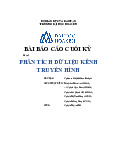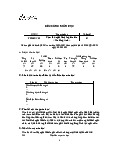















Preview text:
Crisis Communications Plan
The information in this document is for informational purposes only and does not constitute tax, business, accounting, or legal
advice, nor does the information necessarily reflect the opinions of Workshop or any of its advisors. This article provides general
information, which may or may not be correct, complete, or current at the time of reading. Workshop accepts no responsibility for
the accuracy of the information in this article and expressly disclaims al liability for any actions taken or not taken based on the
information in this article. The information contained in this article is not intended to be used as a substitute for specific legal or
other advice or opinions. You should seek advice from the appropriate professional for your specific situation.
This crisis communications plan defines the responsibilities and procedures for communicating
with internal and external stakeholders in the event of a significant, unforeseen business
disruption or threat to the company’s reputation.
At any point, you can find a digital copy of this Crisis Communication Plan here (link) and physical
copies of this plan here (detail location), along with an up-to-date org chart, employee directory,
emergency evacuation procedures, and more.
What’s the definition of a crisis?
We’re defining a crisis as any significant event that creates uncertainty and could have a
long-lasting negative effect on our reputation and/or mission. It may dramatically impact our
ability to operate if it isn’t handled appropriately.
We’ve created a framework to further define these crises and ensure swift action and an
appropriate response to match it, and provided some examples alongside them. These examples
may not always match the level listed here; for example, we may have a Level 3 crisis of executive
misconduct. These examples are used simply to illustrate the gravity of the “level” and ensure that
all parties understand the seriousness of the situation at hand. Level Description 1
This is the highest level of crisis escalation and involves an all-hands-on-deck approach.
The situation is immediate and could potentially result in some sort of calamity, or
another massive threat to the company. The problem may linger for years and require a long term intervention.
Examples: Violence, natural disasters, executive misconduct, excessive outages,
large-scale recalls, data breaches or cyberattacks, or other sudden and unforeseen circumstances. 2
There is a significant potential risk or long-term impact to business operations,
customer success, and/or the company reputation.
Examples: Critical product bugs, outages, large mergers or acquisitions,
employee/customer injury, layoffs, or any other situations that could seriously impact the public’s perception. 3
It doesn’t yet pose a long-term or immediate risk to the business, but the team should
still be on the same page for responding. This level is well-suited for an emerging crisis,
or any situation that can potentially be anticipated or addressed early in its
development to minimize the impact.
Examples: Rumors, corporate restructuring, short service outages, long wait times,
personnel issues, issues with company culture, weather emergencies, etc. 4
This is where most “crises” will fall into. They are typically bigger versions of day-to-day
issues that may need extra effort to be fully resolved and/or addressed.
Examples: Negative Glassdoor reviews, negative tweets from a customer, fire alarms,
other small disruptions to operations, etc.
The crisis communications team T he Point Pe rson
The point person for any and all of these crises is our VP of Communications, Clara Jackson.
If you believe the crisis has a potential to be a Level 1 or a Level 2 (or you are unsure), please contact her
directly and immediately. The First Line
The following individuals make up our ‘first line of defense,’ and will also be informed once the
company is aware of a crisis at Levels 1-3. Name Title Email Phone Number Clara Jackson VP of Communications Charlie McGuire CEO Elaine Johns COO Julian Silva CTO Paige Hudson CMO
Alessandra Pagnotto Director of HR T
he Greater Response Team
If specific (or all) departments need to be brought in as part of the crisis response and/or a larger
response team is needed, these are the designated individuals and their contact information. Name Title Email Phone Number Clara Jackson VP of Communications Charlie McGuire CEO Elaine Johns COO Julian Silva CTO Paige Hudson CMO
Alessandra Pagnotto Director of HR Anthony Keyes VP of Customer Success Nicole Bronson CFO Ari Maeda VP of Product Paula Swann Legal Counsel Mark Barrett Head of Support T
he Communications Team
In an unknown crisis, we have outlined a generic set of roles and responsibilities to help outline our
communications to key stakeholders. Task Name & Title Email
Crisis-specific key messages and updates Internal FAQs External FAQs
Crisis response center set-up and management Spokesperson preparation
Email, voicemail monitoring and response Social media response Spokesperson Media communications Board communications Employee communications Vendor communications Community outreach
Procedure & process
During a crisis, we will follow these steps to fully craft our response statement and get the
communications team on the same page. (These steps are adapted from a similar crisis response
plan from the Nashville Chamber of Commerce.)
1. Determine a location for the crisis response center and begin setup. The crisis response center needs to include: i.
Copies of the response plan, prepared statements and crisis &
communication team contact information ii. Computers and phones iii.
Internet and phone/cell phone access with multiple phone lines available iv. Scanner and copier access v.
Media and social media monitoring software vi.
Media contact lists (print and digital versions) vii.
Social media, monitoring sites and web login information viii. Emergency supplies ix.
Anything else we might need to handle the crisis effectively
2. Convene the communications team to act on communications-related strategic objectives
issued by the first line of response team.
3. Develop a specific communication plan relevant to the actual circumstances of the crisis. It will include:
a. Identifying and prioritizing our audiences.
b. Communication mechanisms for each audience (email, phone call, etc.).
c. Responsibilities and timelines for each task.
4. Assign a team member to create a timeline of the actual events related to the crisis, and
any and all responses given and actions taken.
5. Notify other department heads/the Greater Response Team to help manage the crisis.
6. Fill out the Crisis Factsheet (listed below) with as much information as you have available.
7. Craft key messages related to the actual circumstances (and refine/adapt them as needed).
8. Identify and prepare the spokesperson most appropriate for the situation.
9. Prepare possible response statements for telephone, email, text messages, website, social
media and crisis site inquiries using key messages.
10. Make sure your crisis response center is set up accurately and with copies of the crisis
communications response plan, the response statement and contact information for all
members of the crisis management team and communications team.
11. Assign responsibility to create and maintain phone and email logs of news
organizations/reporters/bloggers/websites covering the crisis and any other key
personnel, client, vendor partner, etc., who may be inquiring about the situation. 12. Notify staff.
a. Use available communication vehicles (Workshop, email, intranet, etc.) to call staff to action as needed.
b. Hold a short briefing meeting onsite, or at a predetermined offsite location or via
conference call, to reassure staff members and prepare them for crisis management.
c. Remind staff of existing media (social and traditional) policies.
d. Set predetermined times for staff members to reconvene to receive regular updates and guidance.
e. Provide staff with key messages to communicate to customers, constituents and vendors as appropriate.
13. Begin contacting those affected by the crisis. Identify best mechanisms to reach each
person, including phone, face-to-face meetings, conference calls, email, media briefings,
press releases, instant alerts, etc. Make specific assignments and include them on the timeline.
14. Avoid a media crisis with response statements posted on your nonprofit’s website home
page and social media feeds as appropriate. If crisis warrants, develop additional online
pages to include press releases, photos, etc. Update all as needed.
15. Set regular times for communicating updates as needed.
16. Contact local emergency officials and government officials as necessary.
17. Make sure those affected by the crisis are being kept informed through regular phone
updates, email updates, RSS feeds, text messages, Intranet messages, etc.
18. Keep your timeline updated, documenting all actions taken and team members responsible
and make accessible to all crisis management team members to review. Crisis Factsheet Event name Crisis level Communication goal DETAILS: What happened? When did it happen? Who is involved? Who is affected? How did it happen? Do we have credible sources of information? What additional facts are needed to put the event into perspective? What is currently being done?
Information that has been confirmed
Source, date, & time
Information that is still unknown Primary contact
Messaging templates
The following templates will be used by the communications team in the event of a crisis we have
not prepared for. Only include definitive facts and not speculative details; verify everything you say.
Make sure that the statement is authentic and appropriate for the situation at hand.
The holding statement should always include: ● A factual headline ● The date and time ● The location of the incident ●
Basic details that have been confirmed ●
When the company was made aware of the issue ●
Actions your organisation is taking that you are willing to make public ●
An expression of compassion or empathy (if appropriate) ●
Contact details OR details on when further updates may occur It should never include: ●
Details that are unconfirmed or uncertain ● Any kind of speculation ●
A response to unsubstantiated rumours ●
Statements of blame or finger-pointing ●
Names of victims in the case of death
HOLDING STATEMENT - GENERIC
We have recently been informed that a [what happened] at [location] involving [who] occurred today at
[time]. The incident is under investigation and more information is forthcoming.
HOLDING STATEMENT - DELAY, DAMAGE, OR RECALL
Yesterday, we learned that several shipments of our [product] have been
[contaminated/damaged/delayed/etc.] due to [specify reason if there is one].
We are working around-the-clock with our [producers/distributors/quality control team/safety inspectors/
transportation providers] and internal teams to ensure your orders/shipments are fulfil ed in the coming
[provide timeline if possible].
We sincerely apologize for any inconvenience this may have caused you, and are working tirelessly to
ensure this issue doesn’t happen again.
Should you have any questions, feel free to contact me at ____@company.com.
HOLDING STATEMENT - TECHNICAL ISSUE/OUTAGE
This afternoon, we were made aware of a technical issue/outage that is affecting our [specify which service or product].
This [issue] took place [date and time] and affected [this group of individuals]. We apologize that we are
not able to provide you with [service or product] at the moment. Our technicians are working diligently to
get our operations to ful functionality as soon as possible.
We wil continue to update you on our progress in resolving this matter at [website] and on Twitter. We
have created a dedicated customer service line to address any inquiries related to this issue. We ask that
you please be patient with our customer support team as they work to help address your concerns/needs.
The support team can be reached at 1-800-123-4567.
We sincerely apologize for any inconvenience this may have caused you, and are working tirelessly to
ensure this issue doesn’t happen again.
HOLDING STATEMENT - OFFENSIVE STATEMENT OR ACTION BY EMPLOYEE Accusation only:
We are saddened by the recent al egations surrounding the [incident/accusation] with/against [employee].
[Company] is committed to being a safe and inclusive workplace for al . We’re stil assessing the situation
and these accusations. We want to understand what happened, and our next step wil be to work with our
[people operations/human resources/executive/legal] team(s) to determine the best course of action. In
the meantime, we would like to offer our sincerest apologies to al of those affected or upset by these accusations. Confirmed evidence:
The viewpoints expressed by this employee do not represent [company’s] values at al , and we empathize
with those hurt, upset, and disturbed by the employee’s [words/actions]. We emphatical y denounce what
[employee] has [said/done], and as a result, have made the decision that we can no longer
[represent/employ/col aborate/partner with] [employee]. We are determined to provide a safe and
inclusive work environment at [company] and are working with our [people operations/human
resources/executive/legal] team(s) to determine the best course of action. Again, we wholeheartedly
apologize to [person/people] affected.
HOLDING STATEMENT - LAWSUIT
We cannot comment on ongoing litigation, but [company] is committed to [statement that does not
divulge information or opinion about lawsuit]. Key messages TARGET AUDIENCE MESSAGE Customers Employees General public/community Media Board FAQ s
Consistent messaging is needed for all of these questions when responding to a crisis. Though we
should anticipate and address specific questions as part of our crisis response planning, this provides a place to start. Target audience FAQs Customers ●
When can I expect [product/service] to be back up and running? ● How does this affect me? ● How will you make this right? ●
What are you going to do to prevent this from happening again? Employees ● When should I report to work? ● Do I still have a job? ●
What happened to my coworker(s)? ● Is it safe? ●
What are we going to do to prevent this from happening again? Management/leadership ● What happened? ● When did it happen? ● What should I do next? ●
What’s the estimated impact to the business? ●
What are we going to do to prevent this from happening again? News/media ● What happened? ● When did it happen? ● What caused it? ● Who is responsible? ● What’s the estimated impact? Crisis debrief
Approximately one to two weeks after the crisis event is substantially or completely handled, run a
full debrief of the event with the communications team. Evaluate both the short- and long-term
impact of the crisis, and how they will be addressed. What did we do wel ? What did we not do wel ? What are our key
learnings for next time? What are the short-term impacts? What are the long-term impacts? What are our next steps to address al of the above?
Specific crisis planning
We have identified (10) scenarios that we want to be prepared for. These are a mix of crises that
are both common in companies on the whole, and specific scenarios that we’ve identified based on
a company risk & vulnerability assessment. ●
Personnel Crisis: an employee or individual who is associated with the company is involved
in unethical or illegal misconduct. ●
Financial Crisis: Bankruptcy, etc. ●
Organizational Crisis: withholding information, exploiting customers, and misusing managerial powers. ●
Technological Crisis: outage, etc. ●
Natural Crisis: tornado, earthquake, etc. ● Unexpected Death/Injury ● Merger/Acquisition ● Regulation/Deregulation ● Layoffs ● Major Product Issue PERSONNEL CRISIS
HOLDING STATEMENTS Accusation only:
We are saddened by the recent al egations surrounding the [incident/accusation] with/against [employee].
[Company] is committed to being a safe and inclusive workplace for al . We’re stil assessing the situation
and these accusations. We want to understand what happened, and our next step wil be to work with our
[people operations/human resources/executive/legal] team(s) to determine the best course of action. In
the meantime, we would like to offer our sincerest apologies to al of those affected or upset by these accusations. Confirmed evidence:
The viewpoints expressed by this employee do not represent [company’s] values at al , and we empathize
with those hurt, upset, and disturbed by the employee’s [words/actions]. We emphatical y denounce what
[employee] has [said/done], and as a result, have made the decision that we can no longer
[represent/employ/col aborate/partner with] [employee]. We are determined to provide a safe and
inclusive work environment at [company] and are working with our [people operations/human
resources/executive/legal] team(s) to determine the best course of action. Again, we wholeheartedly
apologize to [person/people] affected. KEY MESSAGES TARGET AUDIENCE MESSAGE Customers Employees Media Board
You can continue to use the above format for any and al scenarios you identified; include contact
information, specific procedures and processes, and anything else that might be necessary.



